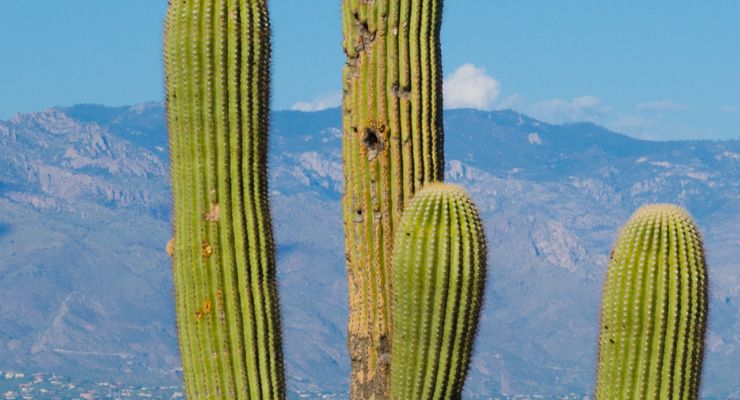Cacti are known for their hardy nature and resilience, but even they are not immune to problems. One such problem that can affect cacti is the appearance of black spots on their stems or pads.
These spots can be a sign of a fungal or bacterial disease, insect infestation, or physical damage.
In this article, we will explore the various causes of a black spot on cactus plants and what you can do to prevent and treat them. Whether you are a seasoned cactus grower or just starting, this information will help you keep your plants healthy and thriving.
Causes and Types of Black Spots on Cactus
Fungal Infections
Fungal infections are one of the most common causes of black spots on cacti. These infections can be caused by a variety of fungi, and they often thrive in warm, humid conditions. Phyllosticta Pad Spotting is one of the most common fungal diseases that can cause black spots on cacti.
Phyllosticta Pad Spotting
This is a fungal infection that affects the pads of cacti. It appears as small black spots on the surface of the cactus pads first, which can eventually merge into larger, sunken lesions. These lesions can cause the pads to become soft and mushy, and the affected area may turn brown or black.
Phyllosticta pad spotting is most common in plants that are grown in humid environments or in soils that are kept too moist. These plant species include Prickly Pear Cacti, aloe, yucca, and orchids.
To treat Phyllosticta pad spotting, it is important to remove the affected pads and dispose of them properly to prevent the spread of the infection. Additionally, you should reduce watering and increase airflow to help prevent the fungus from growing.
Fungicides may also be effective in treating Phyllosticta pad spotting, but be sure to follow the instructions carefully and use the appropriate protective gear.
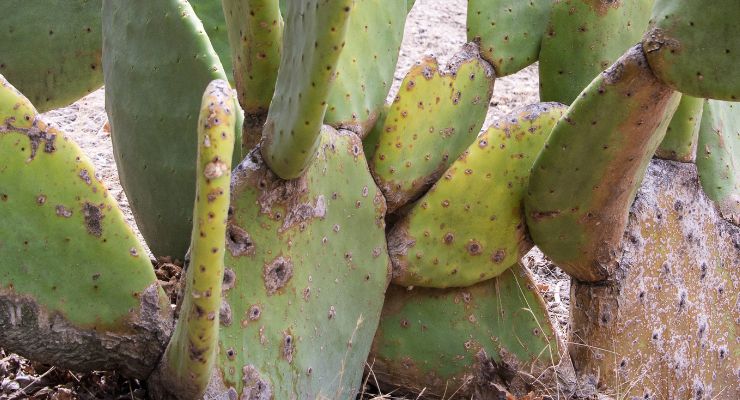
Bacterial infections
Bacterial infections are another common cause of black spots on cacti. These infections can be caused by a variety of bacteria and can be very destructive if left untreated. The following are some of the most common bacterial diseases that can cause black spots on cacti:
Bacterial Necrosis
Bacterial necrosis is a bacterial infection that affects the stems of cacti. It appears as black spots on the stem, which can eventually turn get larger quite quickly. This type of cactus disease can affect just a few cacti species: Saguaro cactus, Cholla, Prickly pear cactus, Barrel cactus.
Bacterial necrosis can cause the stem to become soft and mushy, and the affected area may emit a foul odor. This infection can spread quickly and can be very destructive if left untreated.
To treat bacterial necrosis, it is important to remove the affected parts of the stem and dispose of them properly. The remaining stem should be treated with a bactericide to prevent the infection from spreading.
Crown Rot
Crown rot is a bacterial infection that affects the base of the cactus where the stem meets the soil. It appears as black spots on the base of the cactus and can cause the stem to become soft and mushy. Crown rot is often caused by overwatering or poorly draining soil.
To treat crown and root rot, it is important to remove the affected parts of the cactus and repot it in fresh, well-draining soil. You should also reduce watering and increase airflow to indoor plants to help prevent the bacteria from growing.
Bactericides may also be effective in treating crown rot and root rot, but be sure to follow the instructions carefully and use the appropriate protective gear.
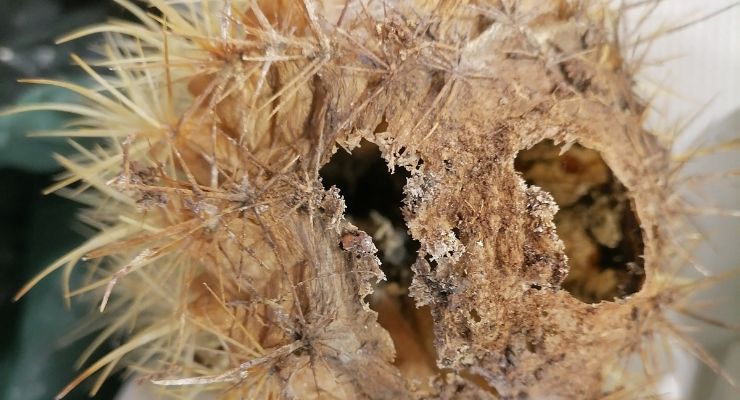
Environmental Factors
Environmental factors can also contribute to the development of black spots on cacti. These factors can include frost damage, fertilizer damage, sun damage, and pest damage.
Frost Damage
This can cause black spots on cacti, which can appear as soft, mushy areas on the stem or pads. This can be caused by exposure to frost or freezing temperatures, which can damage the cells of the cactus.
To prevent frost damage, it is important to protect your cactus from freezing in cold temperatures, by moving it indoors or covering it with a protective cloth or blanket.
Fertilizer Damage
Fertilizer damage can also cause black spots on cacti, which can appear as black or brown spots or black areas on the stem or pads. This can be caused by over-fertilization, which can burn the roots and damage the cactus.
To prevent fertilizer damage, it is important to follow the recommended fertilization schedule and use a balanced fertilizer that is appropriate for cacti.
Sun Damage
It can cause black spots on cacti, which can appear as dark brown or black areas on the stem or pads. This can be caused by exposure to too much direct sunlight, which can burn the cactus.
To prevent sun damage, it is important to provide your cactus with the appropriate amount of sunlight for its specific species and to protect it from the intense midday sun.
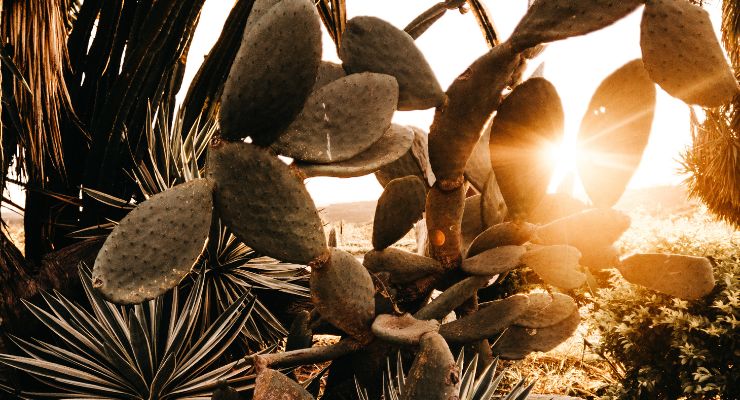
Pest Damage
Pest damage can also cause black spots on cacti, which can appear as small, dark areas on the stem or pads. This can be caused by insect infestations, such as mealybugs or scale, which can damage the cactus and cause black spots to appear.
To prevent pest damage, it is important to inspect your cactus regularly and treat any infestations promptly with the appropriate insecticide.
Identifying Black Spots on Cactus Plant
Identifying black spots on cacti is important in determining the cause and appropriate treatment for the issue.
Visual Appearance of Black Spots
Black spots on cacti can appear as small, dark areas on the stem or pads, or they can merge into sunken and larger lesions. These spots may be black or brown in color, and they may have a slightly shiny or oily appearance.
Texture of Affected Areas
The texture of the affected areas can also provide clues as to the cause of the black spots. Fungal infections, for example, can cause the affected areas to become soft and mushy, while bacterial infections can cause the areas to emit a foul odor and become slimy or wet.
Location of Black Spots on the Cactus
The location of the black spots on the cactus can also provide information on the cause of the issue. Fungal infections, for example, are often found on the pads of the cactus, while bacterial infections are often found on the stem or base of the cactus.
By identifying the visual appearance, texture, and location of black spots on cacti, you can determine the possible cause and take the appropriate measures to treat and prevent the issue from reoccurring.
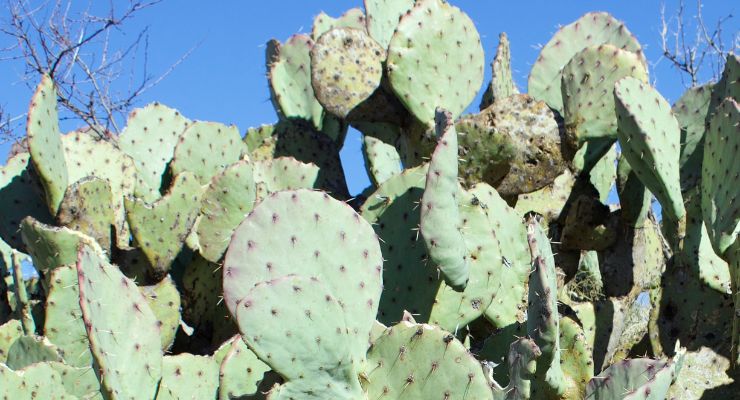
General Steps for Treating Black Spots on Cactus Plants
If you have identified black spots on your cactus, it is important to take the following steps to treat the issue and prevent it from spreading to the entire plant:
Isolate the Plant
Isolate the affected cactus plant to prevent the spread of the disease or pest to other plants. Keep the affected plant away from other cacti until the issue has been resolved.
Remove Damaged Parts
Carefully remove any blackened or damaged parts of the cactus with a clean, sharp knife or scissors. Make sure to cut into healthy tissue to ensure that all infected areas are removed to keep your cactus alive. Dispose of the removed parts in the garbage, not compost.
Freshen up Potting Mix
Remove the cactus from its pot and freshen up the potting mix by removing any debris and replacing it with fresh soil. Make sure to use a well-draining cactus soil mix that is appropriate for the species of your cactus.
Continue Care and Maintenance
Continue to care for your cactus plant by providing it with appropriate amounts of bright light, water, and fertilizer. Avoid over-watering or over-fertilizing the plant as this can exacerbate the issue. Regularly inspect the cactus for signs of reoccurrence and treat any issues promptly.
By taking these general steps, you can help treat and prevent black spots on cacti, keeping your whole plant more healthy and thriving.
How to Treat Black Spots on Cactus Plants
If you have identified black spots on your cactus, there are several natural remedies you can try to treat the issue before resorting to chemical solutions.
Natural Remedies
Neem Oil
Neem oil is a natural fungicide that can help to prevent and treat fungal diseases in cactus plants. Dilute the neem oil with water according to the manufacturer’s instructions and apply it to the affected areas of the cactus. Repeat the treatment once a week until the issue has been resolved.
Apple Cider Vinegar
Apple cider vinegar has antifungal and antibacterial properties that can help to treat black spots on cactus plants. Mix equal parts apple cider vinegar and water and apply it to the affected areas of the cactus with a cotton ball. Repeat the treatment once a week until the issue has been resolved.
Baking Soda Solution
A baking soda solution can help to prevent and treat fungal diseases in cactus plants. Mix 1 tablespoon of baking soda with 1 quart of water and apply it to the affected areas of the cactus with a spray bottle. Repeat the treatment once a week until the issue has been resolved.
It is important to note that these natural remedies may take longer to show results compared to chemical solutions, and it is important to continue proper care and maintenance of the cactus to prevent the issue from reoccurring. If the issue persists or worsens, it may be necessary to consult a professional or use chemical treatments.

Chemical treatments
If natural remedies do not resolve the issue, chemical treatments may be necessary to treat black spots on cactus plants. Here are some chemical treatments that can be effective:
Fungicides
Fungicides are chemical treatments that can help to prevent and treat fungal diseases in cactus plants. Look for a fungicide that is labeled safe for use on cacti, and follow the manufacturer’s instructions for application.
Antibiotics
Antibiotics can be used to treat bacterial infections in cacti. Consult with a professional or your local garden center to determine the appropriate antibiotic for your specific issue, and follow the manufacturer’s instructions for application.
Insecticides
If the black spots on your cactus are caused by pests, such as mealybugs or spider mites, insecticides can be used to treat the issue. Look for an insecticide that is labeled safe for use on cacti and the specific type of pest, and follow the manufacturer’s instructions for application.
It is important to use chemical treatments as a last resort and to follow the manufacturer’s instructions carefully. Overuse or misuse of chemicals can harm the cactus and the environment. Always try natural remedies first and continue proper care and maintenance of the cactus to prevent the issue from reoccurring.
Cultural Practices
In addition to natural and chemical treatments, cultural practices can also help prevent and treat black spots on cactus plants.
Proper Watering and Fertilization
Overwatering and over-fertilizing can lead to fungal and bacterial diseases in cacti. Make sure to water the cactus only when the soil is dry to the touch, and use a well-draining potting mix. Fertilize the cactus only as directed on the fertilizer label.
Pruning Affected Areas
If the black spots are isolated to a certain area of the cactus, pruning that area may be effective in treating the issue. Use clean and sharp pruning shears, and make a clean cut just above the affected area.
It is important to continue proper care and maintenance of the cactus to prevent the issue from reoccurring. Regularly inspect the cactus for any signs of black spots or other issues, and address them promptly.
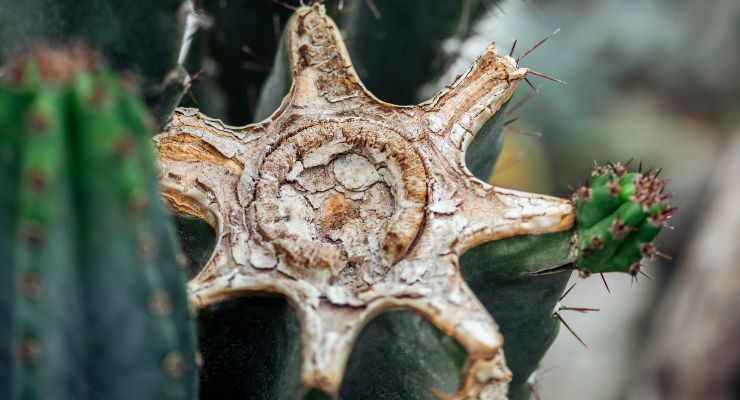
Why is the Cactus Going Grey?
Cacti can turn gray due to a variety of reasons, including:
Natural aging process: As cacti age, their skin can start to become rough and turn gray.
Lack of sunlight: Cacti need ample sunlight to maintain their green color, and a lack of sunlight can cause them to turn gray.
Overwatering: Overwatering can cause cacti to develop root or crown rot, which can turn the plant gray.
Fungal and bacterial diseases: They can cause cacti to turn gray in addition to developing black spots.
Pests: Pests such as spider mites or mealybugs can cause cactus plants to turn gray as they feed on the plant.
It is important to identify the underlying cause of a cactus turning gray in order to properly address the issue. Adjusting care and maintenance practices such as watering, sunlight exposure, and fertilization can help, as well as treat any infections or pests that may be present.
Conclusion
In conclusion, black spots on cacti can be caused by a variety of factors, including fungal and bacterial infections, environmental factors, and pest damage. Identifying the cause of the black spots is crucial in determining the proper treatment.
Natural remedies such as neem oil, apple cider vinegar, and baking soda solutions can be effective in treating black spots on cacti, as well as chemical treatments like fungicides, antibiotics, and insecticides.
Proper care and maintenance of the cactus through cultural practices like proper watering and fertilization, and pruning affected areas can also help prevent and treat black spots.
Regular care and maintenance of cacti are crucial to ensuring their health and preventing issues like black spots from occurring. Proper watering, fertilization, and sunlight exposure, as well as regular inspection for pests and other issues, can help maintain healthy cacti plants.
In summary, it is important to be aware of the causes, identification, treatment, and prevention of black spots on cacti, and to prioritize regular care and maintenance to promote healthy cacti plants.
